#meta analysis
I think the fact that suf is a kids show and pema-death probably won’t happen means that the writing is actually better for it. They can’t use death as a shock tactic like you see in adult shows. This means that the shock/sadness comes from the strength of the writing before/after the death.
Yeah lars died, but the real emotions come from realising that rose/steven can bring people back from the dead. That’s why lion and lars are pink.
Yeah Jasper was shattered, but the real emotions come from realising that steven is capable of shattering someone if he loses control.
I dunno, I just think that’s much more clever than killing off characters as an easy way to make the audience feel sad without actually having to put in the writing. Which more adult shows do all the time.
Hey, I just met you, and this is crazy
But here’s my [number] comm interface, so [call me] maybe we’ll come within range of each other again…




A Defence of Dr John “Jack” Seward
Okay I’ve seen a lot of stuff around and I just want to set the record straight as someone who has done a lot of study in Victorian lit and this book in particular.
Dr Seward is not meant to be creepy.
It is vital that you understand this point. He is an equally viable suitor/lover to Lucy as Quincey or Arthur.
A lot of how he’s been read at the moment is being coloured by the odd 125 years that have past between when this book was first published and now.
Lucy has three suitors, Quincey the Cowboy, Arthur the Lord, and Jack the Doctor. They’re each set up to be equally valid and suitable choices for her. This is why she is so torn about choosing Arthur (i.e. English Stability) over Quincey (American Romance/Adventure) and Jack (Rationality, Intelligence, and - some of y’all won’t believe me when I say this - Compassion).
Jack Seward is odd. There’s no beating around the bush as far as that is concerned. He’s awkward, and nerdy, he has all the latest gadgets, and he finds it easier to talk to Lucy about his passions and interests - such as the very latest discoveries in psychology - rather than engage in social niceties and small talk. He almost sits on his silk top hat and he fidgets with a surgical knife when he’s nervous because it’s the only thing in his pocket. It’s very easy to read him as autistic, or otherwise neurodivergent in some way.
He is also, I cannot stress this enough, at the top of his field. What we see today as archaic and ableist practises were to Stoker’s contemporary reader some of the most compassionate and patient-first mental health work of it’s time. We’re going to learn more about the asylum as we go on, but it’s a very interesting case study of The Other.
The Other is what ultimately rules out Seward as a viable romantic candidate for Lucy. While he is English, “an excellent parti [marriage candidate], being handsome, well off, and of good birth,” while “he is a doctor and really clever,” while “he is only nine-and-twenty, and he has an immense lunatic asylum all under his own care,” he is ultimately too close to the strange and unusual, to the Other, to the mad, to be a good match for Lucy, an up and coming socialite.
She cannot choose Quincey because he is American (foreign and therefore also Other), and engages in lowly things like slang. He is an adventurous and Romantic (used in the classical rather than colloquial sense) Hero, and again ultimately unsuitable for our Lucy.
It is Arthur Holmwood (later The Honourable Lord Godalming), the English gentry that Lucy must court and ultimately wed. This is also why Arthur seems so much less fleshed out and boring compared to the other two suitors. The contemporary reader would immediately understand and fill in everything you needed to know about him from context. He is the most familiar figure to a British public, where the others are … well … Other.
I also want to go over what Jack wrote today, because it’s not nearly as damning as people are making it out to be.
Miserable after being rejected by the woman he loves, Jack throws himself into his work instead. He records his diary on a phonograph, the very latest in Victorian tech, and relates that day’s studies on the patient he finds the most fascinating, R.M. Renfield. A lot of psych work at the time - and today! - revolves around the idea of understanding how a mental patient’s mind works by close analysis, hypothesis, and practical testing and observation. This is what Seward conducts.
Still emotionally unstable himself from the recent rejection, he reflects that there was a level of cruelty in how he treated Renfield that day, which he immediately regrets. He recognises that he went too far, and that it was his own fault, and was irresponsible and wrong as Renfield’s Doctor and as Head of the asylum.
He confesses that he wanted to “keep him to the point of his madness” (i.e. encourage or even worsen Renfield’s condition in order to study it further) something that under normal circumstances would be “a thing which I avoid with the patients as I would the mouth of hell.”
This isn’t a mad scientist gleefully torturing people he considers subhuman, this is a Doctor who cares deeply about his patients and feels terrible his own personal emotional distress led him to hurt rather than to heal.
He let emotion get the better of him, something he considers selfish and indulgent, and he reflects that a selfish man is as much a danger to the people around him as to himself. He resolves to work from a place of duty, from a place which prioritises the well-being of his patients, from now on, and to be more conscientious and aware of his actions and how they affect others in the future.
That is the musings of a Good Doctor! And a Good Man! He is working from a 19th Century understanding of what that means, but that does not minimise the intent and spirit of his character!
Please stop writing Seward off as the creepy asylum man. He is so much more than that, and more than an equal match to Quincey and Arthur.
An Image Meta-Analysis of the ‘Grandma Room’ in the Episode “Into the Wand”
So we all know that there is always a reason and an order to animation - and I think that the four queens emphasized in the “Grandma Room” all reflect an aspect of Star’s person and personality.
The basic thread of my theory is that Celena, Solaria, Eclipsa, and Moon - all were specifically emphasized in the episode to portray certain aspects of Star’s character as she goes through adolescence, leaving behind the key element, which personality represents the fifth point of the s/Star?
When Star first rides into the room in her memory-constructed “Grandma Room” on her father’s chair pulled by Lil’ Chauncy, the doors open to reveal two symbols in the door - a Spade and a Heart (Eclipsa and Star, peoples~).

Now, obviously, there’s a lot of card suits (hearts, spades, clubs, diamonds) imagery in the show and with the Mewni queens so I’ll go into that more.
Next, the scene moves to the skylight slowly opening up into the shape of a star,
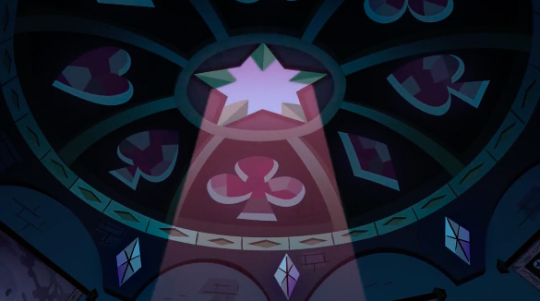
Shedding light first on a suitor displaying the neck of a goose for Celena,

Solaria slaying a monster,

And the half-lidded eyes of our favorite frozen Queen Eclipsa.

These three are the queens that represent the most outward characteristics of Star (again, I’ll go into further detail) but they are also the queens we didn’t know anything about (if release dates coincide with a canon timeline of events). The shot of the suitors represents Star’s romantic prowess - Tom, Oscar, the two-headed demon who worked for Ludo (refer to “Fortune Cookies”). According to the Guide to Mastering Every Dimension, Celena was is a very beautiful, sought-after queen - just like Star.
The shot of Solaria parallels to Star excelling at fighting monsters - the show iscalledStar vs. the Forces of Evil.
And like Eclipsa, she has an affinity for dark magic (her wand turns green MANY times and I did not want to go back through and screenshot all of those times so please believe me! But if you don’t, the episode “Baby” shows this which leads me to think that is what tipped Baby off to the Eclipsa parallel).
Back to big-picture, the next shot shows Star turning her attention to the burger juice on the Wall-Rug of Celena the Shy (and I cannot believe I am devoting all of this time to writing a meta-analysis on a children’s television but here we are).
Welcome.
Celena the Shy (Great-Great-Grandma)
Her inscription reads:
What hides behind the golden fan
the hand does sweetly hold
a trove of cosmic secrets
that never will be told
Celena manifests the element of secrecy and insecurity in Star. For a character that very boldly acts as the Yang of the Yin-Yang balance, Star still holds many many things secret. This is then juxtaposed against Star’s inquisitive side (“Don’t be shy, you can tell me.”) but obviously still points to the fact that Star has a Secrets Closet (“…that’s full of secrets”). As an adolescent, Star is figuring out who she is as a person - but there are things, many many things about her that she is insecure about - her future as Queen, being a magic-user, her crush on Marco, her abilities as a magic-use, etc. She does not know how to effectively deal with this issues, hence the closet. And her go-to behavior is to “Avoid [the] problem until it goes away” (from ep “Face the Music”). This makes up a huge portion of Star’s character, constituting one of the five points.
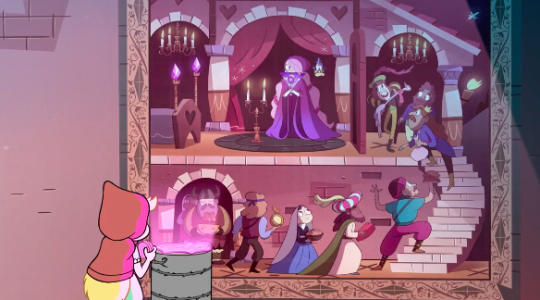
Now for the image-based characteristics of the tapestry.
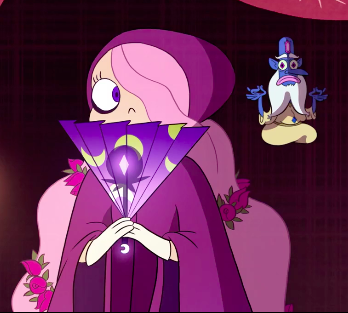
The flowers, I’m thinking, represent the romanticism of Celena, again, being known for her multiple suitors (including a girl~~ so impressed with this show, dudes).
Primarily, her golden fan which is very purple for a gold fan -__- has moon imagery. I’m sure most of you know about Star and the Butterflies being associated with night symbols while Marco Diaz represents the day.
Then, there’s one hidden eye and the other gazing at Glossaryk in fear of being caught(?), in camaraderie of a shared skeleton in the closet(?) - who knows. The inscription even states that she hides a trove of cosmic secrets.
Also, she dons gloves and a cape all to conceal her beauty and her knowledge - which again refers to the traits of secrecy and concealing, and of popularity that Star inherits from her Great-Great-Grandma. There is only so much that Star is willing to share which conflicts with her upbeat desire to over-confide but that’s what is making this show SO DAMN GOOD, you guys, because that’s what adolescence is - finding the balance between your extremes. For Star, she has FIVE.
And the second is her aggression.
Solaria the Monster Carver
Inscription:
A castle stormed is a hero born, with might
as strong as steel. Kneels
the void before
her and the crushing
force she wields

Now THIS is interesting - well…as an English major…I couldn’t help it. Anyways, in the Guide, the inscription is indented by rhyme scheme as are the others - but HERE, in the show, where they had to DRAW IT, on the pedestal - IT IS DIFFERENT. This was specifically formatted differently, not by the rhymes, but by the impact of the content. What struck me here was the unique punctuation of her inscription. “The void before” is separated, accentuated, set apart with her insignia, the lightning bolts - I’m surprised they didn’t just straight-up highlight it. Each of the queens has to deal with a destiny of cosmic proportions - Celena and her secrets, Solaria and the void, Moon and the Toffee, etc. The Queens of Mewni all were mentored by Glossaryk - the thing that always belonged in the tapestries, the one eternal constant, representing the deep intertwining the queens had with grandiose cosmic fates. I bet you, Solaria was the one who brought down the Temple of Monsters, which will - hopefully- parallel to institutions Star might destroy in Season 3 (fingers crossed).
Now imagery,
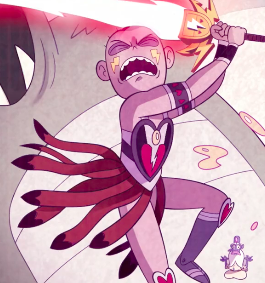
Solaria is defined by lightning bolts and hearts - power and passion. Her eyes closed but her mouth is open, symbolizing aggression without foresight. Solaria is - quite obviously- representing Star’s belligerent aggression, her battle-readiness, her ease with fighting monsters. Again, the show iscalledStar vs. the Forces of Evil. But we know that Star inherited both the good and the bad from this battle-worn grandmother. Star easily jumps into things without thinking it through. Another tension between the extremes as Star tries to balance out and grow as a person.
And then we have…
Eclipsa the Queen of Darkness
Inscription:
Eclipsa Queen of Mewni
to a Mewmen King was wed
but took a monster for her love
and away from Mewni fled

“Oooh, bad girl.”
People obviously caught onto Star’s parallels with Eclipsa with the very obvious “I haven’t seen anything like this since Queen Eclipsa” from episode “Baby” (S2E16A). So I won’t beat a dead goat-pig any further and I’ll go straight into the imagery in this tapestry.
Firstly, the Spades. According to the symbolism of the suits, spades represent winter, wisdom, transformation, and death - fairly fitting of this charismatic queen and her “Monster Love”.
However, with Eclipsa, I don’t think being the queen of evil is not the defining characteristic that is passed down to Star, it’s competence.
Wisdom, intelligence, and prudence are things are favorite Princess Star Butterfly is not really known for - but boy does she have the capacity for it. Her magical potential is boundless and competence is what she inherits from Eclipsa. This queen wrote a whole chapter on a subject that no other queen dared to touch.
Furthermore, we have the all-seeing eye which is a consistent symbol for knowledge on the tip of her parasol, which is Greek/Latin for “shield against the sun” (and I only just realized that’s what parasol meant and I took Latin in middle school you guys…I just..I can’t like I didn’t figure out that Netflix meant interNET and movie flicks…I STUDY THE ENGLISH LANGUAGE AS MY JOB. Anyways.) This refers back to the night imagery of our Mewni queens. This parasol is studded with a glowing diamond - which refers to the intertwining use of suits symbols (that I’ll get into later).
(And can I just say, this tapestry is beautiful - like I saw it in the show and I was like, Damn…this is so well positioned with the symmetry of the whole thing, the demon lover and his arm…so good).
Eclipsa has half-lidded eyes which could represent condescension, scrutiny, mystery, etc - all of which have connotations of I know something and you do not - again, referring to that element of intelligence.
Star and Moon in corners again show a repetition of night imagery, which, I keep forgetting to mention, links to the reversing Yin-Yang balance of Star and Marco. And her four-eyed demon-lover with a ring on the middle finger - mirror parallels to Toffee which makes me and nearly everyone else think that Toffee is the offspring of Eclipsa and her monster love - which would make SO MUCH SENSE AND JUST BE SO POETIC IN TERMS OF NARRATIVE LIKE OMG OK.
Now, we get to…
Moon the Undaunted
Inscription:
The immortal
monster will long
be haunted by the
darkest spell of
Moon the Undaunted
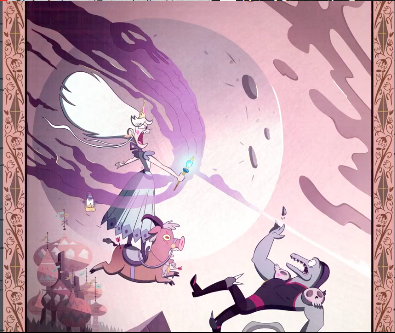
Being Star’s mother, of course,Moon and Star share similarities but from the get go the show seems to push how different these two are. With diamonds on cheeks representing responsibility, values, femininity, judgment - everything a queen ought to uphold, isn’t it strange that her epithet is “the Undaunted”? Moon is a warrior herself but the imagery shows the roundedpersonality of this current queen of Mewni. Circles and the large full moon behind her profile of her fearless (syn. for undaunted) stance against Toffee (who has spades and diamonds on his skull shoulder caps - cough cough). She, like Star, is a warrior-princess but is fully aware of the responsibilities of her title. The castle of Mewni in the background symbolizes her values. To her, her duty as a queen comes first foremost, so the symbol of the kingdom would make sense in being sewn into the tapestry. Star inherited Moon’s fearlessness and courage but also the anxieties of the role of being a princess and future queen, including her part in the grand scheme of her vs. the Forces of Evil.
To recap, Star (1) attracts yet conceals (Celena), (2) is passionate yet aggressive and belligerent (Solaria), (3) has a prodigious affinity for magic both good and dark, (4) is undaunted but also anxious about her fate. Dichotomies and tensions EVERYWHERE. Each point represents a tension that is manifested in a previous queen…
But what is the fifth element/characteristic/person that would make the holistic five-pointed Star?
We have hearts, diamonds, clubs and spades in a deck of cards. But a 5th Dimension deck of cards uses another fifthsuit - yes, yes, YES, a suit of stars.
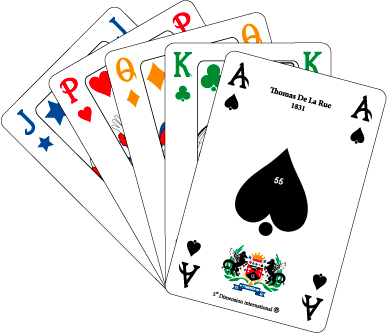
And what is our sun if not a star?
That’s right, and you probably saw this coming, but the last point/element/person/character/whatever probably is…

Brian, the life coach.
(Sorry…couldn’t help it)
Yeaaaaahhh, it’s Marco, duh - but I think it is really what Marco represents in the narrative, which I will leave for Part II, where I’ll talk about the Yin-Yang symbolism, Marco’s destiny and his part in helping form Star’s person, Toffee, and the Suits symbolism of four-five elements coming into play later on.
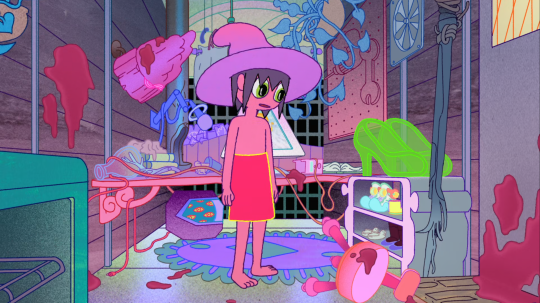
I have another meta-analysis before getting into the plot content of The Midnight Gospel episodes. This time, I’m exploring the recurring motif of Clancy’s taking a pair of shoes with him as souvenirs of his trips to the virtual multiverse, again, highlighting as I did in my previous post that the planets and people he visits are indeed virtual.
But before getting into the shoes at the end of each episode, it is relevant to discuss how each episode begins. Clancy orders Computer, his home A.I., to bring up worlds for him to visit. After which, Clancy gets to choose from a series of custom avatars what he wants to look like for his trip.
The act of shopping for universes and customising exactly how you appear to the world is the epitome of convenience. Clancy isn’t just realising he can buy a product on the Internet instead of going to a store, he’s acquiring a planet and all its natural and artificial riches.
This isn’t a stretch either. Later on in the series, we meet a family of Multiverse Simulator farmers, who mine each world for its expensive artefacts and sell them for money in the tangible reality where the show takes place.
On top of that, each episode has a familiar flow, with Clancy entering the world, conducting his interview, and the world coming to its apocalyptic end, with Clancy hilariously getting caught up in the middle of things. Despite this, Clancy is in no real danger, because at any time he can summon Computer to take him back outside the simulator. Moreover, his body is safely in his home the entire time.
Then Clancy simply proceeds with the rest of his life. He uploads the space-cast and lets the view (yes, singular) roll in.
“Computer, do it NOW”

What’s striking is how transactional Clancy’s relationships with those around him are for majority of the show. He listens to his interviewees and offers them a modicum of respect, but that’s also because for the most part he finds himself agreeing with what they’re saying. The times he doesn’t like what he’s hearing, such as with David, there’s so much resistance, so much tuning out. It’s only David’s patience and gentle prodding that Clancy opens up enough to listen to what he has to say and calm down.
Two things to note on that. First, David is under no obligation to teach Clancy anything. He doesn’t have to put up with an angry octopus who just ruined his painting, came into his place, and started screaming at him. It just so happens that his personal philosophy makes it less likely for occurrences like that to faze him. Second, Clancy wasn’t planning on doing an interview with David. There’s a chance he wasn’t planning to do an interview at all. He was trying to get into the simulator to escape a call he did not want to hear.
Computer calls him out on it as well, saying,
It’s become clear to me that you’ve been avoiding dealing with the real world by going into my many universes.
All the while Clancy is talking over him with the same dismissive attitude, tuning out what advice Computer is giving, just like the phone call or voice messages he’s been avoiding.
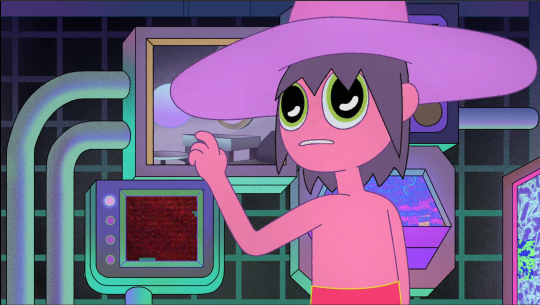
Though we don’t know what Clancy’s life was before the events of the first episode, we do know that since then, he’s been living in a way that suited him. Doing the things he more or less enjoyed. Despite this, he still had responsibilities and generally, just things he didn’t want to do. The most evident in the episode was his severe neglect of Computer, causing the malfunctions that threw him into a fit of rage in the first place.
It’s in this episode that he finally interacts with people outside the simulator. We are introduced to his neighbours, the aforementioned simulator farmers, We meet Bryce, the fidgety Multiverse Simulator repairman. And his interactions with them are transactional. He calls on them because he needs something– a way to fix his simulator. He humours them because he thinks they can offer him what he wants, and when they didn’t, he left them immediately.
In my first post of The Midnight Gospel analysis playlist, I talked about how it was so easy to respond to your own need to be comfortable and satisfied because your needs are immediate and urgent to you. You feel them and when you don’t answer them they gnaw at you and caw at the back of your mind until you satiate them.
I want to emphasise that the harm is not that we are born self-centred. No, that’s a fact of life. We need to take care of ourselves as individuals before we can function in the world we live in. It’s a survival instinct. It becomes problematic when self-preservation and self-comfort are where we stop.
It’seasy to focus on yourself and only yourself, forever. It’s convenient. On top of that, it’s enabled by all our new technology. In the show, it’s having a semi-sentient home A.I. and a multiverse simulator to escape to and profit from.
There are a lot of parallels to this in our world. Digital spaces, personalised content, economic privilege. In these cases, you can just stay in your comfy warm bubble and never leave it.
The Extreme Comfort Zone
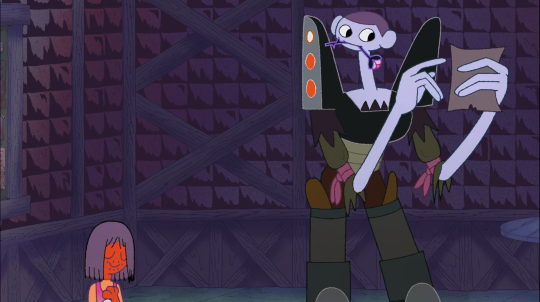
Some concrete examples involve the consumption of media. I don’t want to sound like a crotchety old person and I’m not disparaging anyone. Something I’ve noticed, though, is how my younger family members only watch video streaming sites. Exclusively they watch content that caters to their very niche interests. This stands in stark contrast to when cable television monopolised home entertainment, because you couldn’t decide which shows would air and you couldn’t decide when they would air. You’d have to make an effort to make time for the series you wanted to watch, and in the act of waiting around for a show you were interested in, you’d stumble upon other channels, movies, or series that were interesting.
This is not to say that the democratisation of entertainment is a bad thing. I’m glad that people now have a greater say in the content they consume, they way my younger self did not, and I’m glad people have more spaces to share their niche interests in a way my younger alienated self could only have dreamed. However, this setup brings to the forefront our very transactional relationship with not only mainstream media but individual and independent content creators.
Watching movies is another example. In a theatre, you either sit through an entire movie or you walk out if it’s too unbearable. If a scene is too tense or suspenseful, you have no way of knowing whether or not you’re close to the end or if there will even be a happy resolution.
A habit I’ve noticed with family and friends, especially the younger ones, easily lets me know when they’re bored or uncomfortable. When we’re watching a video or streaming a movie, they’ll tap on the screen to see how much time is left in the running.
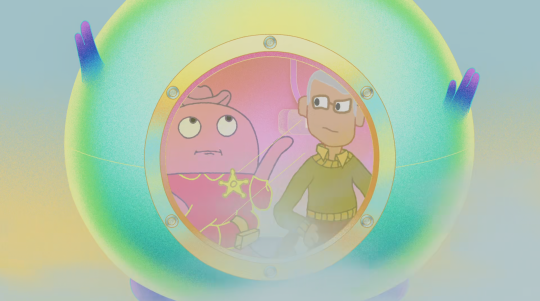
And there’s an underlying message to that. If what we’re seeing or hearing isn’t something tailored to our specific interests, then it’s not worth consuming. If it’s too long, then I didn’t read it. If the art is kind of weird, then it’s not enough to keep watching, no matter the message. (This is real. I know people who tell me they refuse to watch a show like Adventure Time or BoJack Horseman or anyanime because they don’t like the art).
It’s perfectly within one’s rights to skip to end of a book or a film. Life is short. We’re always busy. The modern world has a lot of demands and sometimes you just want to turn off your brain and enjoy something.
But on the rare days you have free time and energy to spare, you can venture outside the realm of what is reassuring and self-affirming. Yes, you can stay in the extreme comfort zone because you don’t have to leave it. You don’t haveto face other people or be confronted by things that make you second-guess your entire way of thinking. But I think you should. Not every moment of every day, because that gets tiring. But once in a while, definitely.
Now how does this all tie back to The Midnight Gospel?
Walking in Virtual Shoes
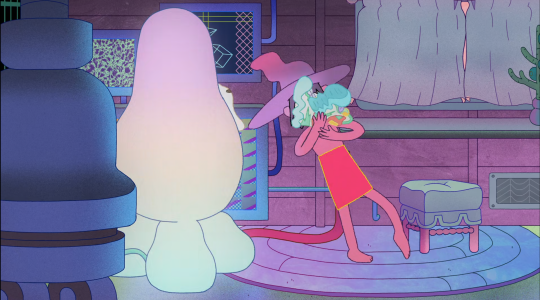
When we get deeper into his backstory, we find out that Clancy has been running away. He’s been refusing to face the relationships confronting him. Like his sister. Talking to her on the phone, she tells him he can’t just keep starting over without facing himself, and it leads him to an angry meltdown in the David episode.
If our worldviews are never challenged, if we are always in our comfort zone, then we never have a reason to turn outward. Because the default setting is to focus on ourselves.
But Clancy does encounter people who regularly challenge his worldview. Even if they’re created by a computer program. And he listens to them. Some more easily than others, but in every episode, eventually, he listens. And they, in turn, affect his emotions and changes the decisions he makes in life.
Again, this is nothing against the younger generations or against current technology. Because I think every generation is guilty of this: Retreating into a comfortable worldview where we don’t realise what other people go through, or don’t think that other people are capable of understanding us. It’s incredibly isolating. In the end, it leads to so much frustration and dissatisfaction, that when our bubble is even slightly threatened, we’re sent into an angry meltdown much like Clancy was.
So, I think it’s very poignant that at the end of every episode, Clancy always manages to take a shoe or two back with him, and these are what he keeps as souvenirs of his trip. This recurring image is significant.
There’s that idiom about walking a mile in someone else’s shoes. Though I think it relates to The Midnight Gospel tangentially, I don’t think it’s exactly what the metaphor of the shoe in each episode means. Clancy doesn’t always take the shoes from the interviewee of the episode. Sometimes it’s just a random shoe he finds on the ground. Sometimes, he takes it from another character. In the last episode, the shoes were pretty much handed to him.

Therefore, I wouldn’t say that Clancy is walking a mile in someone else’s shoes. In fact, in every episode, Clancy remains distinctly Clancy. Each of his avatars have his same color scheme, his eyes, and even his signature hat. During the interviews, he interjects with his own opinions and experiences.
That’s the essence of active engagement with the world, including other people and the media we consume. We listen and then measure it against our own beliefs and values. We re-examine ourselves but that entails having a self to re-examine in the first place.
The shoes represent stepping, quite literally, outside your comfort zone. Even when we’re sitting at home or comfortably, we’ll probably be wearing clothes. But we don’t need to wear shoes if we don’t have to.
The meta is supported by Clancy’s character always presented as being barefoot. In his current lifestyle, he doesn’t need to interact with anyone else. He doesn’t need to do most things he doesn’t want to. He doesn’t need to challenge himself. But in the end, he chooses to, whether he realises or not. Just being open to what the world has to say, especially the people in it, is enough of a first step.
So, to me, the shoes represent having to make that conscious effort of having to put on shoes and go outside. It’s a decision to engage instead of disengaging and curling up inside yourself. You can’t just be thrust into that, or accidentally end up with shoes on and find yourself outside.
——————————————————————————————-
If you enjoyed this post, you might enjoy my other analyses in The Midnight Gospel playlist:
- Some Thoughts: The Midnight Gospel Trailer
- The Midnight Gospel Analysis 01: What’s real and does it matter?
I’ll continue to link to future Midnight Gospel analyses as they come. And as always, my ask box is open.
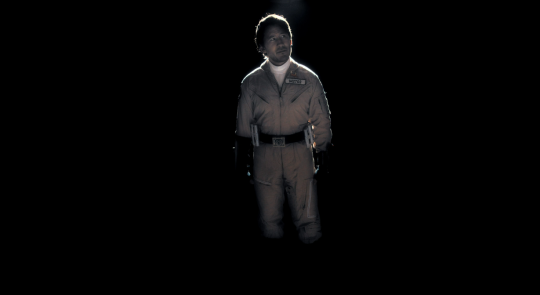
AUTHORS NOTE:
THIS FAN ANALYSIS WILL CONTAIN HEAVY SPOILERS FOR IN SPACE WITH MARKIPLIER (PT. 1 & 2). IF YOU HAVE NOT WATCHED THOSE, PLEASE STOP READING AND GO WATCH THEM, WHAT ARE YOU DOING? If you don’t wish to be spoiled, turn back now! This is your last chance! Go on, Get out of here, go!
Or don’t. It’s your choice after all. But at least now, you know the consequences of your decisions.
For those continuing onward, buckle up for a long one. I loved In Space with Markiplier so deeply, and it resonated so strongly with me, and also with Mark’s other creative works. The man is nothing if not a master of parallels. Grab a snack, and maybe some water. THIS IS 5k WORDS AND A LOT OF PICTURES. YOU HAVE BEEN WARNED.
It’s time… for the End.
ACT I: THE MAN AND THE MIRROR
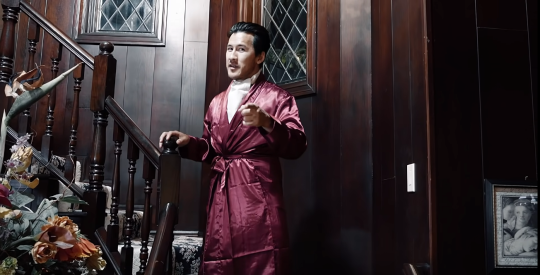
Actor Mark.
We know him. We hate him. We adore him. We abhor him. He is a man we’ve come to realize, collectively, is the one who is behind all of the stories we, the viewer (the DA), go on. This has been apparent since at least DAMIEN, where Actor confesses to making these worlds and putting the ‘other prisoners’ of the house through his stories. It puts Wilford Mother Loving Warfstache into a more contextual light, and also, frames the narrative to his other stories to come.
The biggest, most important part about Mark though, is that he is a man of grief. And once he realized he couldn’t die while in his house, he turned that immense power of creativity into a means of escapism. Escapism from all his problems, all his loss, all his petty mistakes that cost the lives of his friends. He could make everything beautiful again! He could replay the dream, over and over and over again, because that’s all this was, right?

Mark is in a house, with an unlimited lifespan, choosing to make stories where he can move forward and make a beautiful world, a beautiful future. He’s there with Celine, with Damien, with Abe and Wil and then… there’s… us.
The District Attorney. The person who can’t remember who we are and we are constantly put to sleep, just to wake up into a new story every single time with Mark. We go on a Heist with Mark, we go on a Date with Mark. We meet friends, we meet figures who look familiar, and we see a few faces that, tickle our deja vu, who seem to tell us, ‘you know me, you should see me, you are stuck in his stories’ . Darkiplier, the merging of Celine and Damien’s worst qualities into our body, constantly tries to remind us of the horrible things our ‘dear friend Mark’ has done, tries to get us to see. But he can’t tell, if we are awake or still dreaming. Do we even know what’s going on? Surely you must… surely we’ve seen through his mask by now.
But we haven’t. Not until we go to Space. And not until we start to question things, we start to notice the boat is leaking, and everything, everything starts to fall apart.
Let’s take a Detour really quickly.
This will be quick, I promise. It won’t take long. But I want everyone to think, for a moment, back to Wilford MotherLoving Warfstache. Still, in my opinion, one of the greatest things Mark has ever created. As a standalone, and as a side piece to WKM, it is incredible, astounding. And he had the audacity to directly link it to In Space with Markiplier.
This is important. We’re getting there. You see, understanding Space is a bit like understanding what happens in WMLW. In it, Abe the detective is playing his role, and he plays it well. And finally, he gets to the point where he re-finds Wilford, who he’s been hunting for killing him and his friends and his partner. Abe believes the problem is Wilford and is hunting him down to solve those issues.
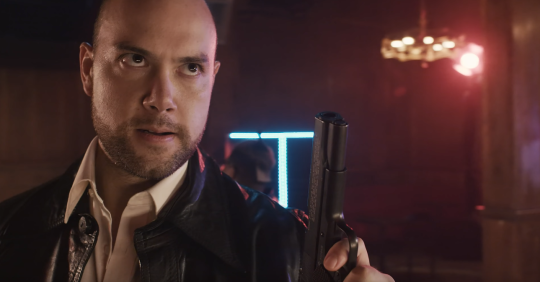
He’s determined, he’s the cop. He’s the good guy hunting down a bad guy. He finds Wilford in a disco. Everything goes according to plan.
Except, of course, when it doesn’t.

Abe sees Wilford, talks to him, and then suddenly begins to question everything he has believed up until that point. The smoking gun of this moment is when Wil doesn’t immediately recognize Abe, and Abe questions how this could possibly be. In doing so, a second Wilford appears, realizes he’s in frame, and then as Abe gets back into character, that Wilford disappears off screen. As WMLW progresses, Abe continues to lose touch with his reality, this dream he’s stuck in, and realizes, suddenly, that nothing makes sense and that he’s still technically dead.
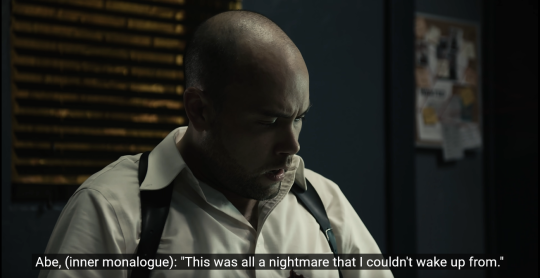
This dream he’s stuck in, he’s realizing, is something that he couldn’t escape. He suddenly realizes he’s been turning his wheel but going nowhere, like a ‘hamster ball rolling down the freeway’. But what Abe doesn’t realize is he’s actually awake for the first time in a long time – aware that the world is broken, confusing, a dream that doesn’t make sense. He’s realizing that the boat is leaking and he’s still on it, sinking. Unfortunately or fortunately for Abe, it was Wilford who woke him up, the man in the whole who is still alive but going mad. He tells Abe he’s been through the same thing, of waking up and realizing, suddenly, that everything is happening to them in a weird dream. But at times, he can’t remember a thing. It’s quite tragic, but also beautiful, these two men realizing that, even in death, there is still something to enjoy, so instead of subjecting themselves to the story again, why not have some fun… outside of it?
Alright Back to the analysis. Where was I again?
ACT II: BUT THATS ALL IN THE PAST
Let’s go back a little bit, shall we? Because to understand Space… we need to understand Mark. Actor Mark, specifically. Yes, we all know that he is a sleazy, near-evil person who forced everyone to his house for a pre-planned party to get back at the people who wronged him. But what isn’t apparent, is what the point of that party actually WAS: To get back at the Colonel for ‘stealing’ his wife, Celine away from him.
So here’s a quick reminder of what happened:
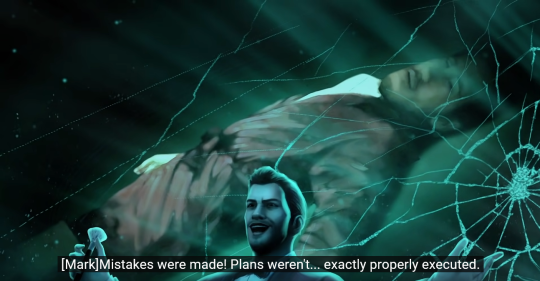
Mark had a plan. A great plan! And in that plan, he was going to frame the colonel for his death and watch it happen, because Mark knew that he couldn’t actually die. The Detective, who was biased into thinking the Colonel did it, would find Mark’s body and would immediately blame the Colonel, because his prior investigations proved the butler and the chef were innocent. The District Attorney, us, would see the evidence, and agree with the Detective without dispute, which we were needed for since Damien wouldn’t be able to point blame at the Colonel, his friend.
But that plan went to ruin.

It wasn’t the detective who found Mark’s body; it was the the DA. Abe didn’t see the Colonel with Mark’s body; he saw us, and immediately placed blame on us for being next to the body. After we were cleared, however, it suddenly wasn’t certain who the killer was. Once that happened, the entity haunting Mark’s house stole Mark’s body back – a body that was already killed by Mark 40 times before and was broken beyond repair. This left Mark stuck in the Void, with no way out.
But when Celine showed up, an opportunity presented itself. The House entity struck a deal with Mark where the House possessed Celine’s body, making sure she would never steal someone’s heart again. Once the house had possessed Celine, it killed Damien – or, at the very least, pushed Damien out of his body. Mark took this body instead, leaving both Celine and Damien in the Void, with nothing but mark’s dead body as company.

Then, everything descends into chaos… and the rest is history.
Basically, Mark didn’t want any of this to happen. Mistakes were made, deals were struck, and all of his friends died or went mad! But it’s fine, he surmises in the end, it will all be fine, because we all can’t die anyway! He knows, he’s tried! Which is great! That means he can make something beautiful out of this, can’t he!
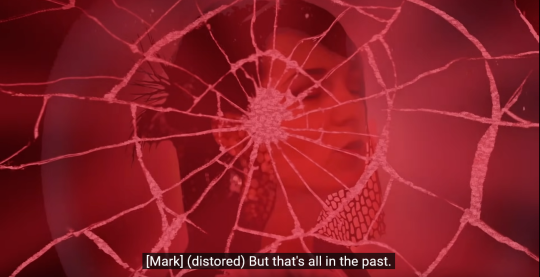
…Can’t he?
ACT III: SPACE IS SO COOL
And so we come back to Mark’s most beautiful creation yet. Space! And the Invincible II, his pride and joy. He has us along for the ride, and nobody to bother him. All of his pieces are in their places. He can’t wait to set off into this intrepid journey where everything is great and they hand the problems of space travel and he is the hero and us, the DA, is along for the ride to watch, just as we always are. We get to see Mark in the starring role once again! But as the story progresses… something starts…happening.
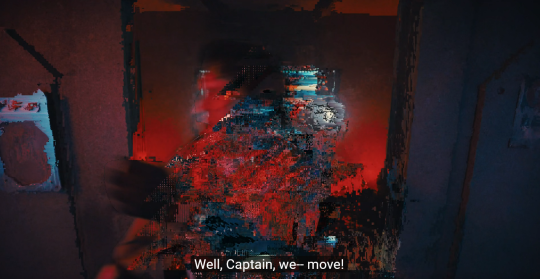
Things don’t seem….Right.
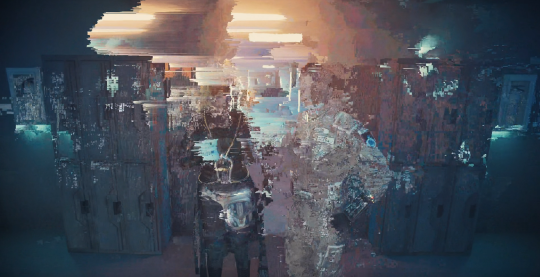
And the more the story progresses…
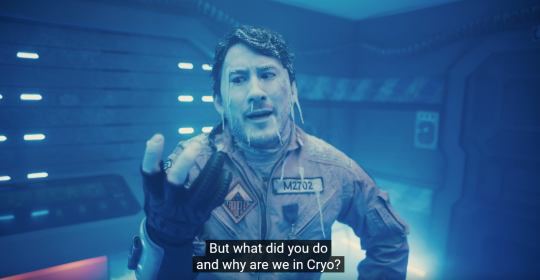
…the more things unravel before our very eyes. Seams fall apart. Back doors are opened. And strange people glitch in and out of existence.
And the strangest part of is all is… unlike his other stories, Mark is… perturbed. He’s out of control, he doesn’t remember things, he’s so lost that he thinks he’s in total control, but also has no idea what is happening and what’s going on. And the worst part is, every time either you or he questions anything, things start to fall apart more and more and more until finally;
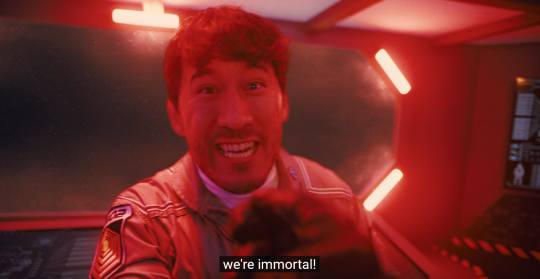
Mark has discovered what you already knew; that their existence has been looping and they’re immortal. Mark, of course, is elated by this news and immediately not only remembers dying, but also remembers the pain of it. This however does not deter him from doing so again. And again. And again. All in an attempt to fix the ship and save the colonists. However, that doesnt seem to be working.
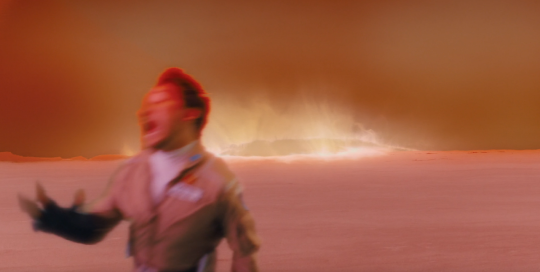
But as he does so, he subtly starts shifting the blame to us. Their failure wasn’t his fault, he was doing the best he could! So what were we doing?

Mark is already starting to show his true colors; how he REALLY feels about the situation. He can’t possibly be the problem, it has to be something with the computer, or with us. He’s the hero, after all. He’s the one who can go back and fix it; fix EVERYTHING and save EVERYONE. He just has to find the right code, the right path, the right solution. He knows he can, he just has to keep trying. It’s infinity after all, right? And he can’t die! So why not keep trying over and over and over again?
Or at least, that’s what he starts to think. Because even though he shifts blame to us at every opportunity (‘It’s their ship, they are the captain’), he does still leave the choices in our hands, at first. And it’s clear that somewhere along the way, he decided that that’s the worst idea and we have done nothing we were supposed to, and doomed everyone.
Eventually, we are confronted with an older Mark, who says ‘To Hell with all of this; we are starting over’. And yet, even in his lunacy, he seems to have a few moments of startling clarity. His character breaks.

He apologizes to us. Tous. Looking through the role we’ve been placed in, he tells us, ‘I’m sorry… about a lot of things’. He also says ‘but when you’ve tried everything else, there’s only one thing left to try.’
He sends us outside of the story. Outside of the cage. Into the Void. The same void he sent himself into, when he couldn’t figure out how to win Celine back. The Void he sent Celine and Damien into, when he couldn’t think of anything else but a deal with the devil.
The story is being reset because Mark has seen us start to become lucid, seen himself trying too hard, and wants to pull the plug. He can’t make anything else better! So now, it’s time to try again, make a new story.
And for a time, he thinks he’s done it.

And then, he forgives us, for everything. Why?

Because its all in the past. And he finally did it! He beat us! We can’t destroy the universe, he did it first! He’s going to save all those people! Why?

Everyone can finally go and live their infinite lives in peace. At this point, we can’t help but wonder… is Mark still talking about the ship? The Invincible II? Up until this point, we assume he has been, but ever since sending everything to the void, he seems to be thinking of others things, other consequences.
Ah well, we won’t find out in Part 1. Because right now, the world is collapsing. The Warp core that disappeared originally suddenly reappears, and what Mark wants can’t happen. And the universe resets and suddenly… horribly…
The Story begins again.
ACT IV: WAKING UP IN A WHEEL
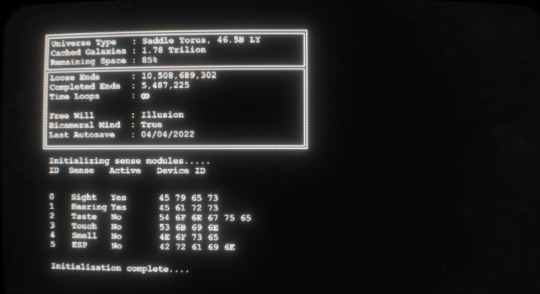
Have you ever heard of the Bicameral Mind? It’s the supposed moment when humans became conscious; when the two divides of the brain came together to form a whole. You see, one side, was the side that seemingly talked, but there was no thought behind it. And then the other half was the half that listened, and obeyed. It’s said when these two parts of the mind merged and met in the middle, that was when our self-consciousness, our self awareness, was evolutionarily born. It is of course a hypothesis, and not yet proven to be true, but here, in the reboot of Mark’s story, in his universe…. It is true.
Free Will is an illusion. And we, we are totally and 100%… aware of it. Like Wilford before us, speaking to a sleeping Abe, we are aware that things don’t make sense, that things aren’t what they should be. Like Wilford, we can now see; our boat is leaking, and its real bad.
The next question is though… is our ‘Abe’ aware, yet? And does he yet know that the boat is also leaking?

Speaking of leaking boats: Shuttle Marmota. You know it’s funny; Marmota is a family of ground squirrels, and the most famous of those ground squirrels is the groundhog. This is a pretty obvious reference here; Mark is harping back to Groundhog Day, a Bill Murray movie where a man relives the same day, over and over, trying to fix the mistakes and get out of his loop. There’s also a recurring theme in Mark’s works about hamsters in wheels. And how they go nowhere. These little rodents that run and run and run, going in circles, but never actually moving forward. They only think they are.
And this section is about one of those little rodents, thinking it’s moving forward, again and again, but they’re stuck. But they don’t know they are stuck. And for better or worse, only we can pull them out of it.
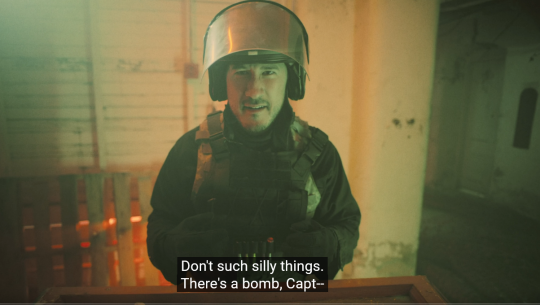
There’s an old saying about ‘getting lost in the sauce’. It’s an idiom that has a few meanings: One is when someone is so inebriated, that can’t tell left from right, and have no idea what’s going on. Another meaning is someone who is wholly preoccupied with a strange event, something out of the ordinary. Another is someone who is completely oblivious to their surroundings. And finally, there is a meaning that is denoted to someone who is neglected, someone who has been feeling abandoned, lost and alone in a crowd of people.
It’s hard to see Mark, Actor Mark, as being someone like that. He’s the one who makes these worlds, after all! He’s got all these beautiful plans, and brilliant stories! Hundreds of them! Millions! Countless! How could he, the creator of these stories, really be lost in his own sauce? How could he get lost in his own stories? That’s impossible, isn’t it? What kind of reason would Mark have, to not only reset the universe, but also reset himself, to the point that even he forgets?

It appears the answer is…remorse. As this new universe starts and we see Mark in different roles, We meet his old self in a diner, and he laments over his decisions, and his mistakes. In doing so, his old self seems to have a moment of clarity:
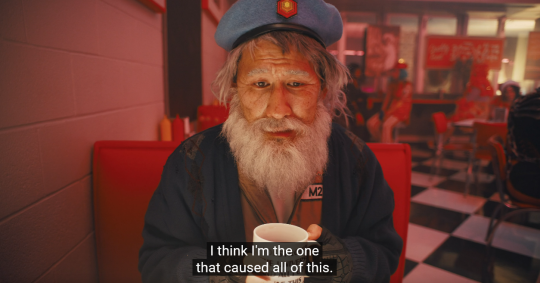
For the first time in the entirety of Space (Or Hell, in the entirety of the Markiplier continuity), Actor Mark tells us that these are his mistakes, and that he is the one to cause all of this. He then instructs us to tell his younger self NOT to go back– we of course, don’t know what this means, not yet, but we will soon. However, its really hard to remind someone of what they shouldn’t be doing, when they are running so hard from their problems that they don’t even know what role they are playing.
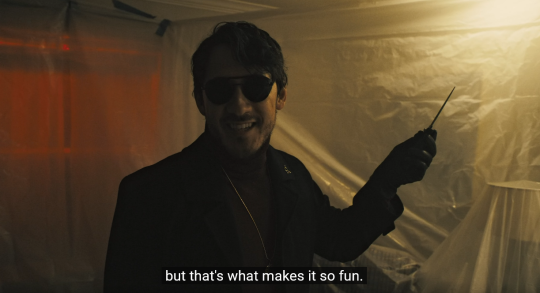
Mark appears to us as a murderer, a divorced father, a lover ready to go on his first date, a porno star, a cryptid named heehoo, a camp counselor, a bomb diffuser. And every time, we have to try and follow him down his rabbit holes. We have to wake up him. And sometimes…
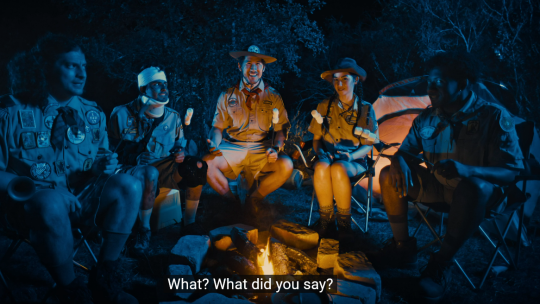
Sometimes, he stops running away. He realizes what’s going on because we tell him. We finally get our hamster, running his wheels, to wake up. The only problem is, every time he wakes up, he’s right back where he started.
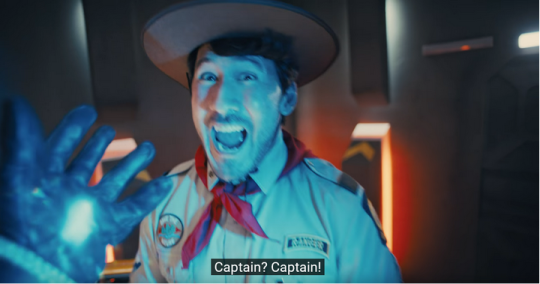
He still blames us.
And it’s incredibly hard, its so frustrating and difficult, for us to see every possibility, every world, every ending, before we can say or do anything. Our semblance of choice, our free will is gone, and we are wide awake to remember all of it. Have we slept? Are we making progress? Are we also slowly getting lost in some sort of sauce ourselves, as we try desperately to spin our hamster wheel in a futile attempt to catch Mark before we lose him again? Does Mark… even want to be found?
Because there does come a time where one has to wonder how much of this is denial, on Mark’s end. The constant running, role swapping, forgetting. He doesn’t want to remember, maybe. Perhaps he wants to forget. Ignorance is Bliss, after all. Easier to forget and start a new world, a new life, instead of having your past mistakes chase after you, again and again.
And what are we, but a past mistake, chasing after Mark’s roles? Trying desperately to get through to him?
ACT V: I CAN NEVER BE FREE
Mark, throughout Space, sometimes feels like a lost cause. But after we wake him up enough times, we start to see moments of… clarity. And this clarity first comes to us in the form of an old friend of ours who helped break out of prison:
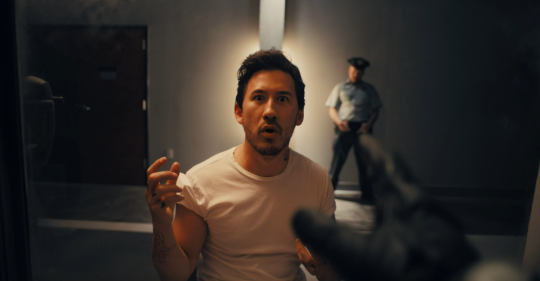
Yancy.
Now, this will be a little controversial, I know. Many people in the fandom adore Yancy, for good reason, but they can take the news that Yancy is actually Actor (someone we have been trained to hate) pretty hard. But whether or not Yancy is truly Actor in disguise, the parallels drawn between these two men and their current predicaments cannot be overlooked. In Heist, Yancy does not want to leave prison; why would he, he has everything he wants! And at that time, Actor had no reason to even think about leaving the House, or his stories. He was content and happy! So why would he want to leave?
But for Yancy, and subsequently Actor, something has… changed their mind.
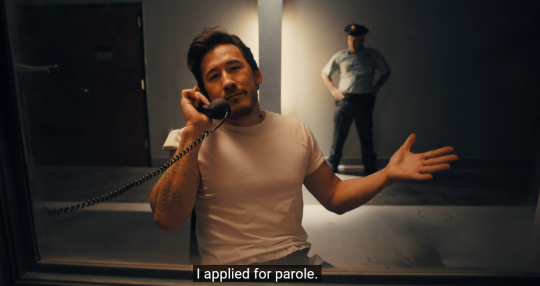
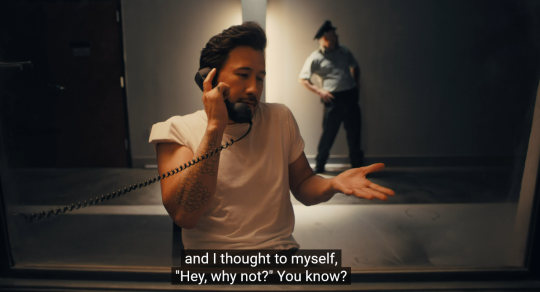
Yancy has chosen parole over being locked up. He thought about what happened, what we said, and has decided… I don’t want to live like this forever. Maybe I should change my circumstances, move on, instead of running my wheel here. Also interesting to note that, while we speak to Yancy, it is through a glass window, one that is reminiscent both of the screen we view the shows through, and the mirror we got locked into.
What does this say about Actor though? It means some part of Actor, despite how much bargaining and denial he may be in, is still interested in getting out of the loop. He’s tired of spinning his wheels. He wants to move on but how? He doesn’t know. He can only have one last hurrah before… before trying to break free. And get out of this place.
Then, as we leave Yancy behind, finally, finally, we start to get the truth out of Mark. ACTOR Mark, not one of his personas. He speaks to us straight. Or,well, in song.
Space was so cool…but now?
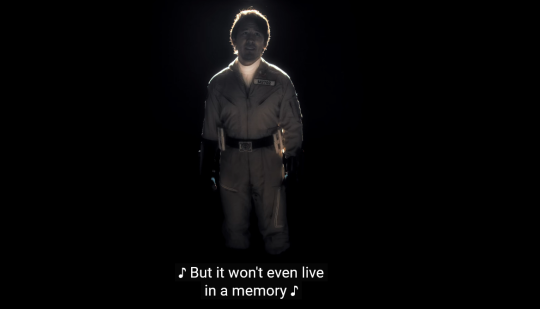
Universe unspooled, so cruel, to be leaving with only a melody… So pretty… What a pity
It won’t live in a memory… because he’s been forcing everyone to forget. To start over. To just play a different role and move on. He so intensely wants to find a solution to the problem, he wants to start trying again, but what will that do? What will it accomplish?
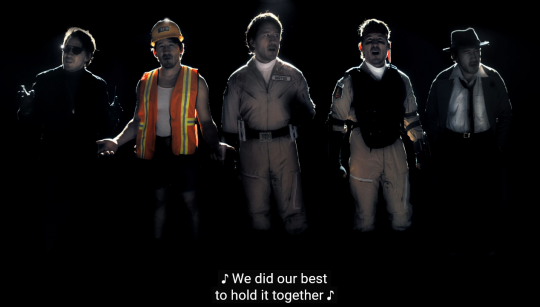
But now its all pulling apart…
Mark is starting to remember… everything. He knows what’s wrong, and he thinks still, if only there was a way for him to uncover every stone, and never give up. “Stay bright till we’re burned”, he says, but what good is it to be burned? To be hurt in the process? What if you’re burned so badly you’re scarred, forever, Mark?
After the song, we are transported directly to the diner… To the end of all things. We meet an old friend once again, and he talks to us about the end. As he does so, he starts to say some… interesting things.

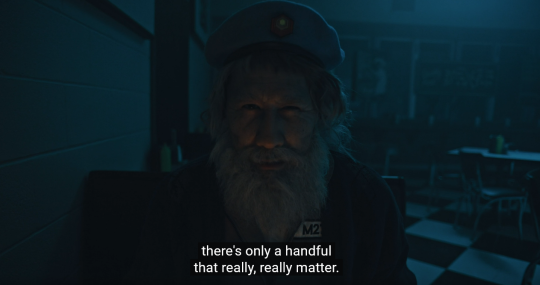
We actually heard this from someone else before… Dorene.

This is most certainly a reiteration of theming, but it is worth noting that this other line comes from her, and that the two ‘elder presenting’ characters in this are the ones that are speaking about how not all choices matter, just a few. Perhaps there is some wisdom there. Some choices are everything, after all.
But it’s what Mark continues with, that is most telling. He tells us that, here at the end of all things, he is content.Happy.

He is this close to finally having an end to all of this. All this… running around, back and forth, going and coming back, living and never dying. He’s so close to an end. His end. But there’s also something else, hidden in those words. A real sadness, of something that was understood far too late into his life by this point.
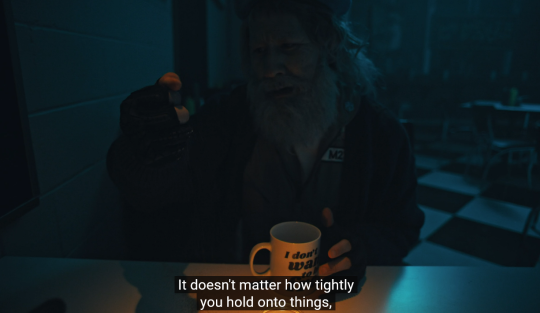
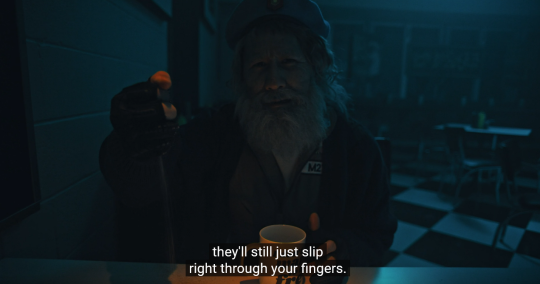

Mark is talking about something entirely out of the purview of the story we’ve been trekking so diligently through. He speaks of loss here, of something he once had, that he held onto too tightly. However, like sand, it doesn’t matter sometimes how tightly you hold onto something, it may still leave regardless. And perhaps, maybe that’s okay. He surmises that mistakes will always happen and that some things, are just not meant to be.
Of course, Actor Mark here is entirely talking about Celine.
Celine, the woman he desperately tried to hold onto. Celine,the woman who broke his heart and left him. Celine, who ran off with his best friend and left him, alone and confused and heartbroken. He agonized over it for YEARS, blaming her, blaming anyone but himself. And it’s only now that he finally understands.
A moment too late, really.
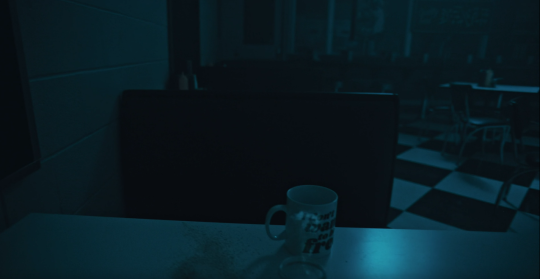
Or is it?
This version of Mark disappears right before our eyes, but we are still here. We haven’t met ‘the end’ just yet. So what is it, then? One can only assume that because this Mark is gone, perhaps the paradox resolved itself. That seems mighty hopeful but then, isn’t that all someone needs, in the end?
ACT VI: THE LAMENT OF THE ACTOR

We open the door. One last, final door. And as we do, we enter into the final act one.. last… time.
Despite the apparel, we arenotgreeted by Head Engineer Mark in this room, oh no. He looks the part, plays it, but there is something else here. Something bubbling under the surface; a resentment, a remorse, an anger and a bargaining chip. The warp core, built by Mark himself, sits in the room. It’s his salvation. It’s his way out.
Hehas to go back. Hehas to save everyone. It’s his obsession, his absolution, his white whale. It’s the only thing he’s ever known. To save everyone, he has to stop us. He is dangerously sure of it.
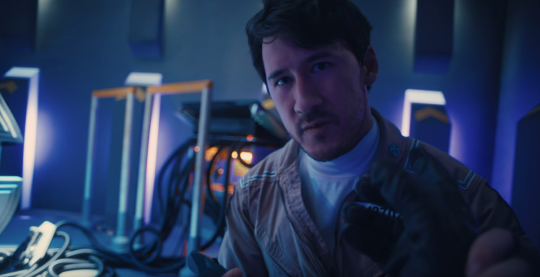
Remember, back in Act II, where I recalled Mark’s plans? His perfect revenge to get back at Colonel all falling to pieces, because of us being in the wrong place at the wrong time? Keep that in mind, because it’s important, going forward.
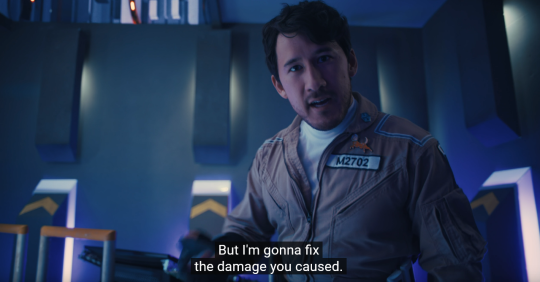
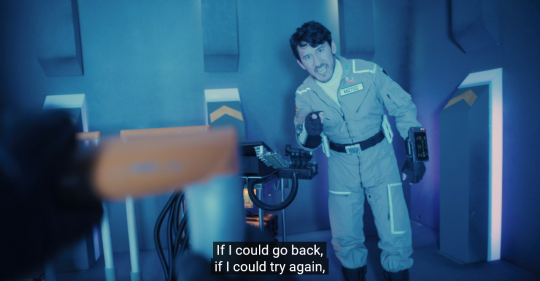

Mark is still convinced that we are the problem here. He’s laying it all on us in a huge, prepared monologue. Who knows how long he has been sitting on this, thinking about this, ruminating over the warp core and the decisions made long ago that he can’t figure out how to undo. He’s thinking about all the friends he’s lost, all the grief he feels, and howhe’ll be the hero, if only hecan stop us from doing… whatever it is we did. And suddenly, in the most pivotal moment of all…
We learn Mark doesn’t even know what it is that we’ve done.
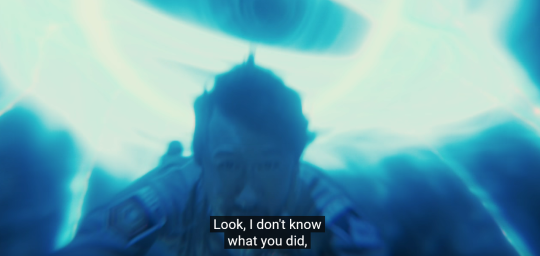

And it isn’t until we refuse to let him go, when we hold onto our hope does he start to understand, fully, the ramifications of our actions.
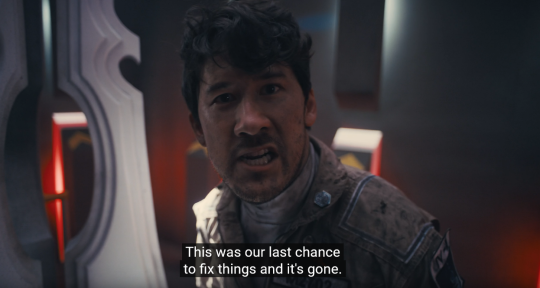
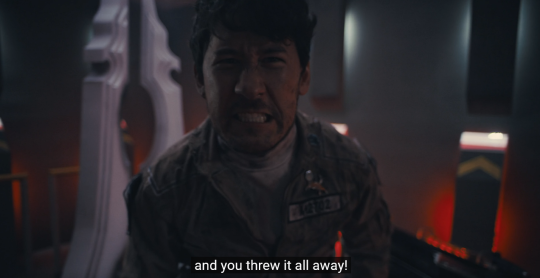
Mark is grieving. He wants to go back and fix things. He isn’t just talking about the ship anymore, though to his credit, he keeps that act up rather well. What we are seeing here is a Mark that has had an eternity to think about what happened and was so sure that if he went back and fixed what we did wrong in his plan, nobody would die. But the world doesn’t work like that. The party still happened; we can’t change it. We can’t change the past and undue the mistakes we’ve done.
Once Mark realizes this, once he realizes what would happen if he chooses to never go back, He has his full wake up moment.

If I’m not back then… the party doesn’t happen?
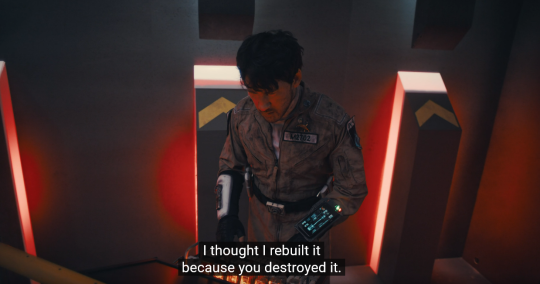
But I thought the problem was you, because you were the wrench in my plan.

But I caused the problem at the party?

I caused all this.
And as soon as Mark makes this realization, that he finally understands that he caused the problems… the By Lake Surprise piano overture begins to play. This is song that binds everything in the Who Killed Markiplier series together, this piano key denotes somber tones, character realizations, and the tragedy of endings and beginnings. This is Actor, finally, coming to terms with what happened and suddenly realizing that… He caused the pain of his friends and drove Celine away.

For the first time, Actor is honestand we see the real Mark. We see, probably, for the first time in the entire series, the man that Celine fell in love with, who Wil and Damien was best friends with, before a broken heart and an evil, possessed House turned him into a warped, angry version of the man he once was. A man blinded by his rage and agony, that for countless lifetimes, he believed that everyone else was the problem. And only now is he seeing what it really is. And he realizes… He’s tired. He hasn’t slept in ages. He can’t even die properly. He’s been running shows and going down rabbit holes for eons and eons… for who knows how long. This is a man suddenly bearing his soul to us, his full amount of pain and tragedy, on the floor, at the end.
And for the first time, he says this and he means it.


hey folks, I’m gonna introduce you to two very important fandom terms and they are watsonian anddoylist
they come (obviously) from the sherlock holmes fandom, and they are two different ways of explaining something in a story. say I’m a fan and I notice that, in the original books, watson’s war wound is sometimes in his leg and sometimes in his shoulder. the watsonian explanation is how watson (that is, a person within the story) might explain it; the doylist explanation is how sir arthur conan doyle (a person in real life) would have explained it.
sherlock explains the migrating war wound by making the shoulder wound real and the limp psychosomatic. the guy ritchie films explain it by having the leg wound sustained in battle before the events of the film and the shoulder wound happen onscreen. the doylist explanation, of course, is that acd forgot where the wound was.
this is very important when we’re discussing stuff like headcanons and word-of-god. I see this when people offer watsonian explanations for something, and then a doylist will say something like “it’s just because the author wrote it that way,” and I see it when a person is criticizing bad writing/storytelling (for example, the fact that quiet in metal gear solid v is running around the whole game in a bikini and ripped tights) and someone comes back with “but there’s an in-story reason why that happens!” (that reason being she breathes through her skin).
there’s nothing wrong with either explanation, and really I think you need both to understand and analyze a text. a person coming up with a watsonian explanation has likely not forgotten that the author had real-life reasons for writing something that way, and a person with a doylist interpretation is likely not ignoring the in-universe justification for that thing.
but it’s very difficult (and imo often useless, though there are exceptions) to try to argue one kind of explanation with the other kind. wetblanketing someone’s headcanon with “or it could just be bad writing” is obnoxious; dismissing someone’s criticism with “but have you considered this in-universe explanation” is ignoring the point of the criticism. understanding where someone is coming from is important when making an argument; acting like your argument is better because you’re being doylist when they’re being watsonian or vice versa is not.
it’s been 5 million years but this thing still gets notes with like “can someone explain this to me in a shorter, easier way” so here it is:
watsonian: the enchantress cursed the eleven-year-old prince from beauty and the beast and all of his servants because fairies don’t understand why humans would think that’s insane and unfair. I am using in-universe evidence to explain why the character might think or act a certain way, as if belle and the prince and the enchantress are real people.
doylist: the writers didn’t realize that the prince would have been eleven when he was cursed until it was too late to change it, and the servants are also cursed because talking furniture is funny and allows for unique character design. I am explaining this plot point based on an outside knowledge of how writing works and how writers think.

